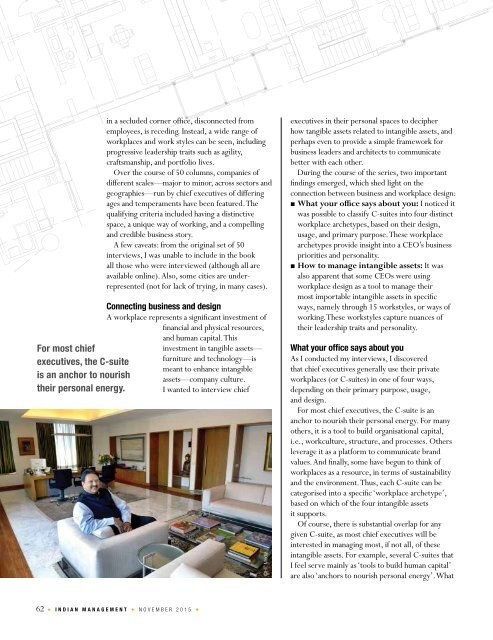the new hr
1NT8tPl
1NT8tPl
Create successful ePaper yourself
Turn your PDF publications into a flip-book with our unique Google optimized e-Paper software.
For most chief<br />
executives, <strong>the</strong> C-suite<br />
is an anchor to nourish<br />
<strong>the</strong>ir personal energy.<br />
in a secluded corner office, disconnected from<br />
employees, is receding. Instead, a wide range of<br />
workplaces and work styles can be seen, including<br />
progressive leadership traits such as agility,<br />
craftsmanship, and portfolio lives.<br />
Over <strong>the</strong> course of 50 columns, companies of<br />
different scales—major to minor, across sectors and<br />
geographies—run by chief executives of differing<br />
ages and temperaments have been featured. The<br />
qualifying criteria included having a distinctive<br />
space, a unique way of working, and a compelling<br />
and credible business story.<br />
A few caveats: from <strong>the</strong> original set of 50<br />
interviews, I was unable to include in <strong>the</strong> book<br />
all those who were interviewed (although all are<br />
available online). Also, some cities are underrepresented<br />
(not for lack of trying, in many cases).<br />
Connecting business and design<br />
A workplace represents a significant investment of<br />
financial and physical resources,<br />
and human capital. This<br />
investment in tangible assets—<br />
furniture and technology—is<br />
meant to enhance intangible<br />
assets—company culture.<br />
I wanted to interview chief<br />
©HT Media<br />
executives in <strong>the</strong>ir personal spaces to decipher<br />
how tangible assets related to intangible assets, and<br />
perhaps even to provide a simple framework for<br />
business leaders and architects to communicate<br />
better with each o<strong>the</strong>r.<br />
During <strong>the</strong> course of <strong>the</strong> series, two important<br />
findings emerged, which shed light on <strong>the</strong><br />
connection between business and workplace design:<br />
• What your office says about you: I noticed it<br />
was possible to classify C-suites into four distinct<br />
workplace archetypes, based on <strong>the</strong>ir design,<br />
usage, and primary purpose. These workplace<br />
archetypes provide insight into a CEO’s business<br />
priorities and personality.<br />
• How to manage intangible assets: It was<br />
also apparent that some CEOs were using<br />
workplace design as a tool to manage <strong>the</strong>ir<br />
most importable intangible assets in specific<br />
ways, namely t<strong>hr</strong>ough 15 workstyles, or ways of<br />
working. These workstyles capture nuances of<br />
<strong>the</strong>ir leadership traits and personality.<br />
What your office says about you<br />
As I conducted my interviews, I discovered<br />
that chief executives generally use <strong>the</strong>ir private<br />
workplaces (or C-suites) in one of four ways,<br />
depending on <strong>the</strong>ir primary purpose, usage,<br />
and design.<br />
For most chief executives, <strong>the</strong> C-suite is an<br />
anchor to nourish <strong>the</strong>ir personal energy. For many<br />
o<strong>the</strong>rs, it is a tool to build organisational capital,<br />
i.e., workculture, structure, and processes. O<strong>the</strong>rs<br />
leverage it as a platform to communicate brand<br />
values. And finally, some have begun to think of<br />
workplaces as a resource, in terms of sustainability<br />
and <strong>the</strong> environment. Thus, each C-suite can be<br />
categorised into a specific ‘workplace archetype’,<br />
based on which of <strong>the</strong> four intangible assets<br />
it supports.<br />
Of course, <strong>the</strong>re is substantial overlap for any<br />
given C-suite, as most chief executives will be<br />
interested in managing most, if not all, of <strong>the</strong>se<br />
intangible assets. For example, several C-suites that<br />
I feel serve mainly as ‘tools to build human capital’<br />
are also ‘anchors to nourish personal energy’. What<br />
62 INDIAN MANAGEMENT NOVEMBER 2015


